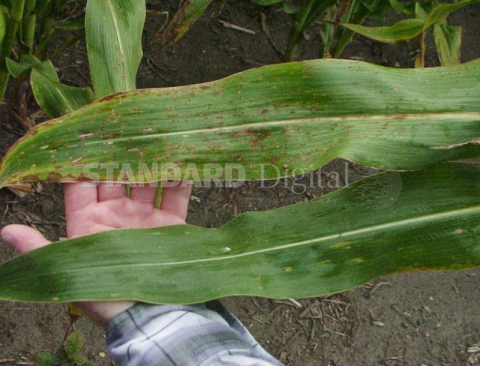
NAIROBI: Nutrient deficiency is likely a big problem during the growth phases every season.
The high cost of fertilisers has left farmers with little option but to plant their maize without applying fertilisers or using little quantities that cannot meet their crops’ nutrient requirements.
Apart from stunted growth, the plants will show various colours, meaning they do not have important nutrients that promote healthy growth.
Sometimes, it is difficult for farmers to tell if their crops suffer from mineral deficiencies or diseases.
Most deficiencies are confused with viral diseases.
However, through proper observation a farmer can tell whether a plant is suffering from nutrient deficiency or a disease.
Below are all the major nutrients plants require and methods farmers can use to address deficiencies:
Nitrogen
Nitrogen promotes the growth of plant leaves and shoots. It is the most important nutrient for plant growth and forms part of the many essential compounds such as proteins and chlorophyll.
Chlorophyll gives plants their green colour and plays an essential role in manufacturing food for the plant. It increases leaf growth and makes leaves more healthy and soft.
Nitrogen deficiency symptoms: A low supply results in yellowing of the leaves but the green colour of the leaves darkens once the nitrogen supply is increased. Excessive nitrogen on the other hand results in large leaves that are soft and prone to insect attacks, fungal infections and other disease-causing agents.
Excessive nitrogen supply increases the growing period of cereals and delays maturity. In root crops, too much nitrogen results in large leaves and small tubers.
Prevention: Build organic matter levels in the soil. Grow nitrogen fixing green manures or use nitrogen rich organic fertilisers.
Phosphorus
Stay informed. Subscribe to our newsletter
Phosphorus is the second most important nutrient mainly required for the growth and development of plant shoots and roots, especially in early stages of growth.
Young plants absorb phosphorus rapidly and a crop like maize has peak demand for phosphorus at just three weeks of growth. Lack of phosphorus at this stage may cause problems difficult to correct later in the season.
Phosphorus deficiency symptoms: Plants without adequate phosphorus show stunted root systems, stunted leaves and stem, a dull greyish-green leaf colour and purple colour especially of the cereal leaves.
Prevention: Apply mijingu rock phosphate or plant teas from tithonia.
Potassium
Potassium is the third most important nutrient in plant growth. It helps manufacture plant food that promotes the growth of shoots and roots.
It also helps in the movement of manufactured plant food from the leaves to other parts of the plant. Potassium helps the plant resist diseases.
It is particularly important in regulating water in the plants.
Potassium deficiency symptoms: When potassium is in short supply, the plants become stunted; develop small pale leaves. The leaves dry prematurely, first at the tips and then along the outer edges. The fruits and seeds become small and weight reduces.
Prevention: Improve soil structure. Use plant-based potash such as comfrey leaves or comfrey liquid. Add wood ash to compost heap and apply to the soil.
Trace elements
Trace elements include a number of heavy metals like iron, zinc, copper, molybdenum and two non-metals, boron and chlorine.
These are called trace elements because they are needed in small quantities.
For example a maize crop yielding 6.3 tonnes of total dry matter per hectare removes only 70 grams of copper from the soil.
However, they are important because plants lacking one of these elements may show yellowing of the leaves, death of growing points and even a change in the growing patterns of the plant.
Importance of organic matter
Organic matter is important in the soil. Organic matter is provided by dead or living plants and animal residues. It is a major source of plant nutrients such as nitrogen, phosphorus and sulphur. Organic matter protects the soil from erosion and therefore loss of essential nutrients. It holds the soil while allowing air and water movement.
The major source of organic material are crop residues, weeds and animal manures. Any soil with organic matter of between 3.5 and 7 per cent is good for plant growth.
The writer is the editor of ‘Organic Farmer’ published by International Centre of Insect Physiology and Ecology (ICIPE)
 The Standard Group Plc is a
multi-media organization with investments in media platforms spanning newspaper
print operations, television, radio broadcasting, digital and online services. The
Standard Group is recognized as a leading multi-media house in Kenya with a key
influence in matters of national and international interest.
The Standard Group Plc is a
multi-media organization with investments in media platforms spanning newspaper
print operations, television, radio broadcasting, digital and online services. The
Standard Group is recognized as a leading multi-media house in Kenya with a key
influence in matters of national and international interest.
 The Standard Group Plc is a
multi-media organization with investments in media platforms spanning newspaper
print operations, television, radio broadcasting, digital and online services. The
Standard Group is recognized as a leading multi-media house in Kenya with a key
influence in matters of national and international interest.
The Standard Group Plc is a
multi-media organization with investments in media platforms spanning newspaper
print operations, television, radio broadcasting, digital and online services. The
Standard Group is recognized as a leading multi-media house in Kenya with a key
influence in matters of national and international interest.






